Useful Guide To Know The Difference Between American And English Labradors
This post may contain affiliate links. We may earn money or products from the companies mentioned in this post.
If you’ve spent any time at all reading about Labrador Retrievers, the terms “American Labrador” and “English Labrador” simply must have come up, being very commonly used terms when describing different types of Labs.
But what do these terms mean?
How did these terms come about and make it into common use?
Is it just the country of their birth or are there other differences between them?
In today’s article we’re going to cover the differences between an English Labrador Retriever vs an American Labrador Retriever.
As a guide dog puppy raiser we’ve had the pleasure of raising and training both English Labs and American Labs witnessing first hand the differences between these two breeds within a breed.
Are There Really Different American And English-Type Labradors?
The distinction between American and English-type labs is not an official one, but the types are now almost universally recognized by all and there are distinct differences between them.
The terms are commonly used and widely known and accepted nicknames for Labradors with ancestry from the respective countries, but also that have been bred for different purposes.
QUICK RECOMMENDATION: We’ve read many books and magazines about Labrador Retrievers. One of our favorite books, The Complete Labrador Handbook is a great resource for all Lab owners.
The English Lab Vs American Lab Breed Differences
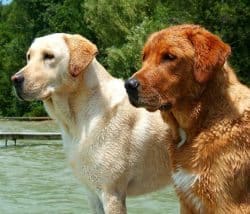
The English and American Labradors are distinguished as either show (conformation) dogs or hunting (field) dogs respectively.
In general, these types of dogs are friendly, dependable good nature, playful, and love human companionship. They are popular as companions and as service dogs. Moreover, the Labrador is first and foremost a retriever.
Labradors bred for show and conformation have become commonly known as English-type Labradors as they’re more common in the UK.
Labradors bred for field trials and hunting have become commonly known as American-type Labradors as they’re way more common in the USA.
But perhaps confusingly, there are American Labs that enter dog shows and there are English Labs competing in field trials and used for hunting.
The terms “American Labs” and “English Labs” aren’t absolute and strict terms, but more a useful guide of the probable type of Lab being described. There are many exceptions.
Do The English vs American Lab Breed Standards Differ?
The UKC, the AKC, and no other national registry or parent club of Labrador Retrievers contain in the breed standard or recognize in any way, a difference between American and English Labradors.
They simply do not differentiate between Labs.
There is one Labrador breed standard, and that is that. All Labs should meet the same standard, there is only one Labrador Retriever.
There is no “American Labrador Retriever” and there is no “English Labrador Retriever” there is simply ‘The Labrador Retriever.’
With this said though, there is one slight difference in allowable height between the American and English breed standards:
The American breed standard allows a height of between 21.5 to 24.5 inches while the English breed standard allows a height of 21.5 to 22.5 inches.
This is probably in recognition of the fact the American Labs can be taller and longer in leg…but more on that later.
With the exception of this difference, the two Labrador breed standards are essentially the same. They describe exactly the same dog.
So why do people say there are two types?
The Breed Standards May Be The Same, But Side By Side They’re Very Different!
Seeing an American-type and an English-type Lab side by side really does highlight some startling differences.
Here is a brief description of the differences you’d typically see in their physical appearances.
What Does A Typical English Type Or Show Bred Labrador Look Like?
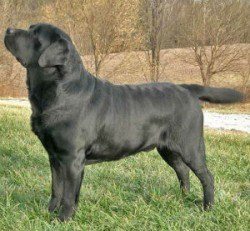
When compared to an American-type lab, the English type:
- Looks more substantial with a heavier look about them. Blockier and bigger built with barrel chests, they’re noticeably wider and more “solid” looking.
- They have a wider head with a more pronounced and better-defined stop, a fuller face, and a shorter muzzle which further adds to their more solidly built appearance.
- Has a thicker, more powerful-looking neck.
- Has a very noticeably thicker coat.
- They have a wider, thicker, and generally straighter tail than their American cousins.
- Has shorter legs and hence doesn’t stand quite so tall.
- Has a shorter body.
- Bred for conformation they’re usually far closer to how the breed standard is written than the American type.
What Does A Typical American or Type Labrador Look Like?
When compared to an English-type lab, the American type:
- Has a lighter, slimmer-looking body. With a more athletic build, lithe and finer boned, they look more agile and “ready to go”.
- They have a head that’s not as wide as their English cousins. The skull and face are noticeably narrower, and their muzzle is more streamlined and longer than the English lab.
- Has a thinner and longer neck which adds to its more lithe and athletic look.
- Has a noticeably thinner coat.
- Generally has a tail that is thinner and less “otter-like” than an English Lab. It looks longer and some even have a little curl to them.
- Has longer legs and so is taller when compared to an English lab. In combination with their slimmer build, this further adds to their look of athleticism.
- Bred for working ability, there’s far less desire for breeders to aim for the breed standard so they’re almost always less closely matched to how the breed standard is written.
Is there a Difference Between Labrador and Labrador Retriever?
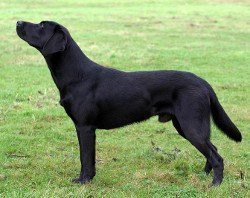
All Labs should meet the same standard, Labrador and Labrador Retriever are the same dog. There is no difference, there’s just only one Labrador Retriever (Canis familiaris).
In the Labrador breed standard, there is only one Labrador Retriever.
Difference In Energy Levels, Disposition, And Overall Temperament
Although not always true and there are exceptions, generally speaking, there is a profound difference in the temperament and energy levels of the American and English types:
Energy Levels And Temperament of American Labs
As a rule, they’re bred for work and field trials, so the American Lab has a higher energy level and “drive” than their English cousins.
They’re noticeably more active and “always on the go”. But of course, higher energy levels are needed in a dog with such demands placed on them as working all day.
The higher energy levels and drive have earned them the label of being more high-strung as they really are always active and need constant exercise and attention.
In terms of temperament and perhaps due to the mix of high intelligence and high energy, they’re considered more headstrong and need a more experienced and strong-in-character owner to achieve control and a well-behaved and balanced pet than does an English Lab.
Without a doubt, the American type is more suited to life as a working dog than as a relaxed family pet.
English Labs Energy Levels and Temperament
The English Lab is considered calmer, less active, and quieter in nature than the American Lab.
More often described as sweet, mellow, extremely relaxed, and quieter when compared to American labs, they’re considered easier to train and to live with for less experienced and laid-back owners.
Although still “driven” and suitable for life as a working dog, if a family pet is what’s desired, the English lab is far more likely to slip into this role as they’re far less demanding when it comes to activity and will more readily chill at your feet at the end of a hard day.
Temperament and personality traits common to both breeds
Regardless of type, when it comes to being loving, affectionate, and an immense desire to please, both the American and English Labradors are equally matched.
True to the breed standard and part of what makes a Lab a Lab, both the American and English types are highly intelligent, keen, and biddable. Very kind in nature, bold and confident whilst void of any aggression.
But you should be aware that differences in energy, ebullience, and being headstrong and controllable do exist between the two types.
Reasons For The Difference Between American vs English Labradors
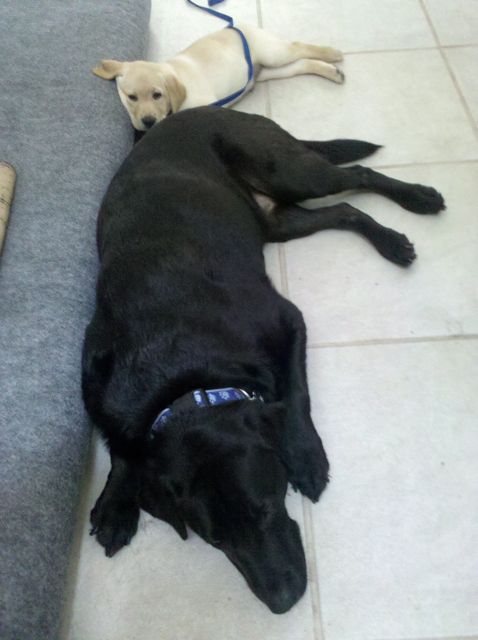
The reason for the difference between the English lab vs American lab is due to many decades of specialized breeding.
Labradors bred especially to hunt and compete in field trials are selectively bred for their working abilities.
Higher energy, higher drive, more athletic, slimmer built, and agile dogs, are the most desirable traits in a working Labrador.
They’re bred with far less regard for conformity to the breed standard and more for their ability to perform than a Labrador bred for show.
Labradors bred for show in conformation competitions are selectively bred for their looks and temperament alone, with the Labs most closely matching the breed standard and winning awards in the ring going on to be used in breeding programs.
Their ability to perform in hunting and field trials is secondary at best.
It used to be a Labrador conformation and working ability was equally important, with many breeders aiming for the prestigious ‘double champion’ who would win in both the ring and out in the field.
But the two disciplines have become so specialized and competitive in recent decades that double champions have become rarer and rarer with breeders having to concentrate on just the one area to stand any hope of success.
This is what’s led to the branching off of the two distinct types and the trend is likely to continue and the differences are likely to become even more pronounced.
Why You Might Choose An American, Field-Trial Type Labrador
Specially bred to have the qualities needed in a successful working dog, the American type is very active, with boundless energy, stamina to match, and an adventurous and strong-minded attitude.
As a comparison to humans, they’re much like an Olympic athlete and truly physically elite.
An American Lab is suitable if you’re looking for a hunting partner, want to get involved in field trial competitions or have a very active outdoor lifestyle.
However, as a family pet and house dog, I think they have way too much energy and are too hyperactive than the average family can handle.
They need a lot of exercise, constantly need to have their minds occupied and hence will take up a lot of your time.
If you’re not ready for this and cannot provide the level of activity they need, you may find they get bored and try to entertain themselves and this is when people say they have a problem Lab on their hands.
Perhaps then an English Lab would be more suitable…
Why You Might Choose An English, Show Type Labrador
Specially bred for looks and temperament to match as closely as possible to the official breed standard, the English-type Lab is perfect if you have any intentions to compete in conformation shows or wish to go into breeding.
But they’re also far less exuberant, less full of energy, and aren’t as highly strung when compared to an American-type Lab.
They tend to calm down after puppyhood much sooner and are more eager to please and easier to train as a well-behaved companion.
This is because they haven’t been bred for high drive, courage, dogged determination (pardon the pun), and peak physical performance.
So if you’re looking for a Labrador that won’t be too high energy to manage, is easier to train, less demanding of activity and time, and is more suited to life as a family pet, then you should choose an English Labrador.
Please don’t take this to mean that an English Lab is low on energy and easy to manage!
They’re still highly intelligent and energetic dogs that need regular exercise and their minds to be occupied, but compared to an elite American field trial or hunting Lab? Well, they’re worlds apart!
An English Lab is far more suited to life as a family pet. But a high-energy family all the same 🙂
Will There Ever Be An Official Split Of The Two Types?
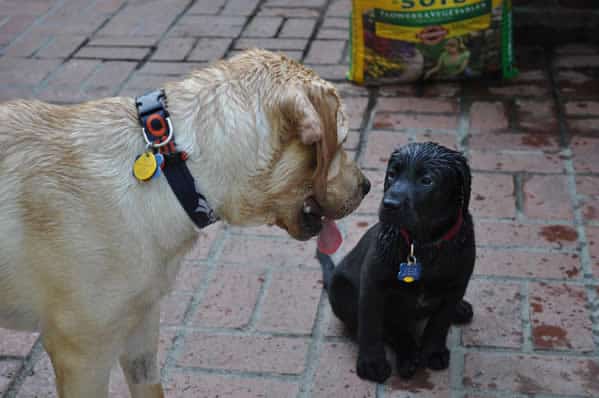
The split of Labradors between the English and American types, or the field trial and show types, is very ingrained and accepted terminology within the Labrador world in general even if not with the official parent clubs and kennel clubs of the world.
But the differences that exist between American and English Labs are undeniable and becoming more prevalent as the breeding lines of those for show and those for working Labs become ever more separated.
Some breeders, particularly those from the American field trial genre feel that the show ring no longer gives their dogs the recognition they deserve.
The more ‘true to standard’ English labs always win in the ring leaving field trial champions to be less and less recognized in the show.
So there is lots of debate about splitting the breed into two types and I guess we’ll just have to watch this space to see what occurs.
Conclusion
There are quite considerable differences between “American-type Labs” and “English-Type Labs”, both in looks and disposition. So which type is best for you?
This depends on your lifestyle and what you want from your dog.
American-type Labradors are generally more athletic, energetic, more highly driven, and better suited to an outdoor life of hunting and sports, or for families with a great deal of energy and real outdoor types.
English-type Labradors are blockier and bigger built, calmer, more docile, and better suited for life as a family pet…but still an active family nonetheless.
To choose between the types, do a little research, be honest with yourself about which would best fit into your pace of life, and try to meet a few of each type to see which you prefer.
If you know what you’re after before you ever approach a breeder then you’re much more likely to end up with a Labrador that best suits you, and a Labrador will end up with an owner that is best for them.
“American-type Labradors” aren’t always more energetic and demanding, “English-type Labradors” aren’t always more relaxed and easier to handle, but the types are true enough to be a good guide and a place to start.
Are you still yearning for more information about Labrador Retrievers? One of our favorite books is The Complete Labrador Handbook. It has tons of information about our favorite breed.
Save to Pinterest:
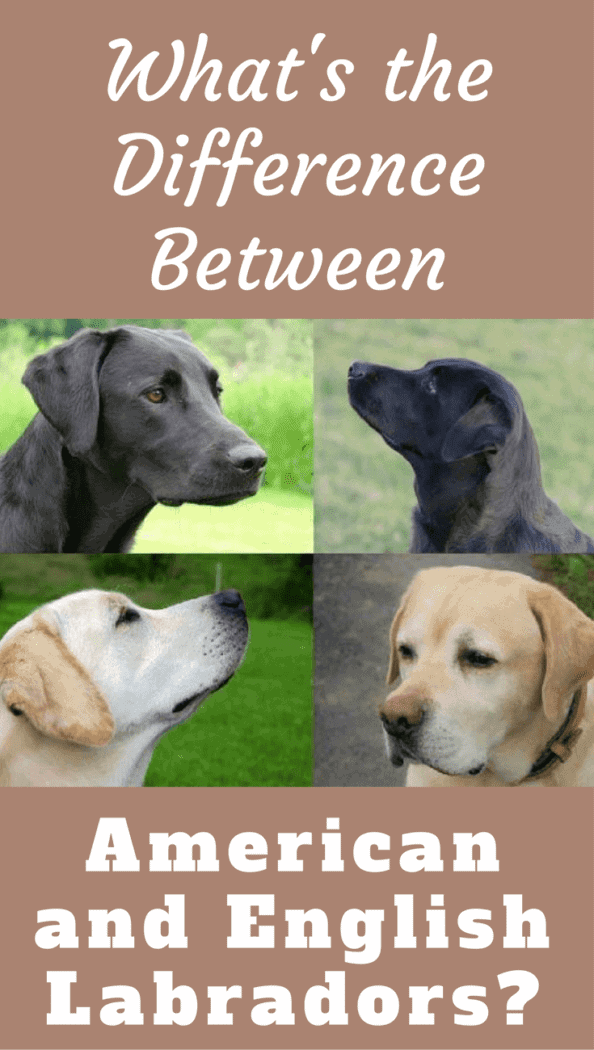
Top Picks For Our Puppies
- BEST DOG CHEW
We Like: Beef Collagen Sticks - All of our pups love to bite, nip, and chew. We love using Collagen Sticks to help divert these unwanted behaviors. - BEST PUPPY TOY
We Like: Calmeroos Puppy Toy w/ Heartbeat and Heat Packs - Perfect for new puppies. Helps ease anxiety in their new home. - BEST DOG TREATS
We Like: Crazy Dog Train-Me Treats - We use these as our high-value treats for our guide dog puppies. - BEST FRESH DOG FOOD
We Like: The Farmer's Dog - A couple months ago we started feeding Raven fresh dog food and she loves it! Get 50% off your first order of The Farmer's Dog.
Check out more of our favorites on our New Puppy Checklist.

I wish all descriptions referring to an “ immense desire to please” would be rephrased as a desire to “partner.”
I live in England and we have two different types of Labrador which are working type and show type. Show type are preferred by breeders and pet homes and are generally chunky in build. Working type are leaner and more athletic and are favoured by those who go on pheasant shoots and as assistance dogs and for active homes.
Never heard of an ‘American’ labrador.